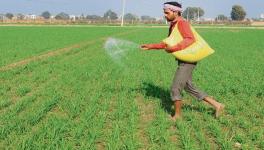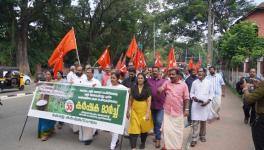Odisha Farmers Travel to Palwal to Join Agitation Against Farm Laws
Chamru Soren’s pale eyes and shrivelling, greying skin say a lot about him; they narrate a tale of destitution, poverty and hunger. Yet, his grit is unparalleled. Soren and his friends have travelled 1,800 kilometres from Bhuwaneshwar in Odisha to extend their support to the agitating farmers camping at the National Highway 2 in Haryana’s Palwal against the recently enacted farm laws and the Electricity (Amendment) Bill.
The farmers have been agitating against the three laws facilitating corporate farming, establishment of private mandis beyond states’ laws and removal of limits for stocking essential commodities. The farmers’ unions have also opposed the proposed Electricity (Amendment) Bill, which, they believe, would lead to exponential increase in electricity costs for the farming community. The Bill has proposed a new billing structure under which the customers are required to pay the cost of bringing the electricity to their households. It effectively means that rural consumers will have to pay higher rates for electricity.
Soren and his friends maintain that they are participating in the historic agitation to diffuse the government propaganda claiming that it’s a movement of the farmers from Haryana and Punjab only. “Godi media keeps telling us that it’s a protest of Punjab and Haryana farmers only. We came here to emphasise that it is a plain lie. We are similarly suffering like farmers in the rest of the country and will be affected in the same manner,” he told NewsClick.
Sala Marandi, sitting beside Soren on hunger strike, says that the laws, if implemented, will alter the basic structure of agriculture in the country. “The government framed the laws without any consultation with farmers. In fact, they are completely unaware about the diversity in agrarian systems across the country. If I talk about Odisha, 60% of the state grows only one crop in a year. Rest of the 40% can grow two crops because they have some access to irrigation. Additionally, we follow a system of bhagchasi or sharecropping.”
Jatin Mohanti, a member of the All India Kisan Sabha, interjects: “The biggest impact will be on the Dalit and Tribal communities in the state who constitute 17% and 23% of the state’s population respectively. These communities are predominantly sharecroppers. If landowners enter into a contract with any company, these people are the ones who will be displaced. What will they do to feed their families?”
“We are already battling a crumbling procurement system in the state. You must be surprised to know that we do not have a single government mandi in the three districts Nabarangpur, Keonjhar and Gajapati despite Nabarangpur being the largest producer of maize in the entire Asia with an estimated 8 lakh metric tonne production per year. We are still awaiting a processing plant in the district. Secondly, the government keeps reiterating that it has increased the MSP. But what did we really get? The MSP for maize is Rs 1,850 per quintal; whereas, we had to sell at Rs 1,100 per quintal. It does not cover even the input costs,” says Mohanti.
When asked about the input costs, he further explains, “If I were to give a rough estimate, we spend some Rs 15,000 to Rs 20,000 per acre; whereas, we get around Rs 25,000 for the produce. Please remember that we save about Rs 5,000 for the entire year. In this situation, we have no option but to migrate. The data with the Odisha government suggest that about 50 lakh youths have migrated out of the state which has a population of 4.37 crore.”
Marandi says, “What will people do? There is no income in agriculture. The minimum wage in the state is Rs 207 per day. Construction workers get about Rs 250 per day. How will they survive? Navin Babu (Chief Minister) has his head buried into sand like an ostrich in the face of rampant corruption. It was his duty to ensure that tribals get their pattas under Forest Rights Act, 2006. But he simply cheated us by promising one lakh jobs per year. Our cotton farmers are committing suicides. The companies and their middlemen traded death with us. They would stop the supply of fertilisers, seeds, and pesticides when we needed them most. Then they would sell it at an increased price with 5% interest per month. So, if I buy something worth Rs 100, I need to pay Rs 160 at the end of year.”
“You know they said privatisation brought good things. When we see the magnificent private schools and hospitals, we are reminded of our poverty. We see those schools, but cannot send our children there for education. We cannot take our elderly for treatment,” he adds.
Asked if they see resolution on the horizon, Mohanti says, “We believe in the democratic process of a dialogue. But democracy mandates the government to listen to people, and not to the sponsors of the ruling party!”
Also read: Modi Govt Paralysed, Farmers Prepare to Escalate Protests
Get the latest reports & analysis with people's perspective on Protests, movements & deep analytical videos, discussions of the current affairs in your Telegram app. Subscribe to NewsClick's Telegram channel & get Real-Time updates on stories, as they get published on our website.























